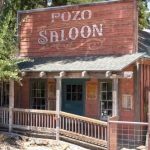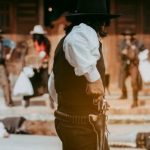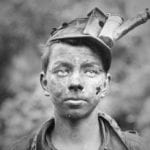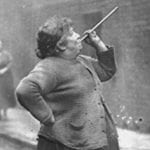 Crime
Crime  Crime
Crime  Technology
Technology 10 Hilariously Over-Engineered Solutions to Simple Problems
 Miscellaneous
Miscellaneous 10 Ironic News Stories Straight out of an Alanis Morissette Song
 Politics
Politics 10 Lesser-Known Far-Right Groups of the 21st Century
 History
History Ten Revealing Facts about Daily Domestic Life in the Old West
 Weird Stuff
Weird Stuff 10 Everyday Products Surprisingly Made by Inmates
 Movies and TV
Movies and TV 10 Actors Dragged out of Retirement for One Key Role
 Creepy
Creepy 10 Lesser-Known Shapeshifter Legends from Around the World
 Animals
Animals 10 Amazing Animal Tales from the Ancient World
 Gaming
Gaming 10 Game Characters Everyone Hated Playing
 Crime
Crime 10 Terrifying Serial Killers from Centuries Ago
 Technology
Technology 10 Hilariously Over-Engineered Solutions to Simple Problems
 Miscellaneous
Miscellaneous 10 Ironic News Stories Straight out of an Alanis Morissette Song
Who's Behind Listverse?

Jamie Frater
Head Editor
Jamie founded Listverse due to an insatiable desire to share fascinating, obscure, and bizarre facts. He has been a guest speaker on numerous national radio and television stations and is a five time published author.
More About Us Politics
Politics 10 Lesser-Known Far-Right Groups of the 21st Century
 History
History Ten Revealing Facts about Daily Domestic Life in the Old West
 Weird Stuff
Weird Stuff 10 Everyday Products Surprisingly Made by Inmates
 Movies and TV
Movies and TV 10 Actors Dragged out of Retirement for One Key Role
 Creepy
Creepy 10 Lesser-Known Shapeshifter Legends from Around the World
 Animals
Animals 10 Amazing Animal Tales from the Ancient World
 Gaming
Gaming 10 Game Characters Everyone Hated Playing
Ten Harsh Realities of Common Jobs in the Old West
The Wild West era of American history is often romanticized as a time of rugged outlaws and fearless lawmen. Those people really did exist, of course. But there was much more to this period than just gun battles and train robberies. Beneath the surface of the popular narrative lies the story of everyday people who kept frontier society running. That included bankers, railroad workers, shopkeepers, and ranch hands.
These rugged settlers worked hard to make a living, just as we do today. Even if it wasn’t in a wild manner like cops and robbers, much of their work was honest. And their contributions to the growth and development of the West are just as important as those of the famous gunslingers and lawmen.
While the Wild West may seem like a distant and foreign world, the people who lived during that time were not so different from us. They had to find work and pay for their livelihoods. In turn, they made a life for themselves and their families. To that end, the variety of jobs available during this time was quite diverse. From blacksmiths and stagecoach drivers to merchants and saloon keepers, commerce ruled out West.
In this list today, you’ll learn all about the truth behind ten jobs held by America’s westward pioneers. Some of these sure aren’t as wild as you might think. And they all have a reality far different than the Old West stereotypes so often presented in pop culture!
Related: 10 Wild West Lawmen Who Were More Dangerous Than The Outlaws
10 Ranch Work
There’s a good reason the image of the cowboy is ingrained in American culture today. That’s because it was a legitimate and adventurous way to earn a buck out West! On the big screen, the cowboy is a romanticized figure in American culture. He is often portrayed as a heroic and adventurous individual. But the reality of the job was far from glamorous.
The cowboy’s main responsibility was to protect cattle on the ranch where he lived. This was no easy task back in the day. Bandits and outlaws were known to steal cattle constantly. Then, the thieves would sell the valuable meat and hides on the black market. A cowboy had to be constantly vigilant. Think of him as a high-end security guard—with plenty of back-breaking physical duties to carry out, too.
Now, the cowboy is often associated with American culture, but the origins of the profession can be traced back to Mexico. The Mexican cowboy, known as a vaquero, had the same duties as their American counterpart. He was tasked with protecting and overseeing cattle. But the manual labor was often the most brutal part. To be successful in this profession, one had to possess certain skills. These included roping, lassoing, herding, fence-making, and riding.
Cowboys earned decent wages for the time. Many took in between $25 and $40 a month, which is equivalent to about $1,000 to $1,500 in today’s currency. However, the work was grueling. Long days often exceeded the modern 8-hour workday. And there was no paid time off or anything like that. The work droned on until it was done![1]
9 Law Enforcement
The image you almost certainly have of the Wild West is that of a lawless frontier. You see it being overrun by gun-slinging outlaws, right? Well, that’s a common scene perpetuated by movies and pop culture. But the reality of the era was quite different. There were certainly instances of banditry—and we’ll discuss that below—but the overall level of lawlessness was not as widespread as depicted. In fact, law enforcement jobs were some of the most consistent and high-prestige gigs in the region!
In the absence of a formal law enforcement structure from the state, fledgling towns in the Old West had to establish their own methods of order. This led to the rise of strongman figures like sheriffs, deputies, and bounty hunters. They brought criminals to justice and proudly defended their communities. Additionally, lawyers, judges, and executioners were well-paid to ensure outlaws were punished accordingly.
As formal society moved westward in time, the region offered a variety of legitimate work opportunities for those seeking to uphold the law. Positions such as U.S. Marshals were commonly found in more established towns. And the need for paid, full-time law enforcement officials was high throughout the frontier. However, as with any system, there were opportunities for corruption. Some towns became known as “outlaw towns.” There, the local government was controlled by criminals and corrupt city managers.
Over the years, state lawmen would work to fight back against the grift. Bounty hunters would swoop in, too. They could make big bucks working somewhat outside the structure of the law. Of course, their jobs came with considerable risk to themselves. But despite all that, the West provided a unique and exciting opportunity for those willing to take on the challenges of law enforcement. Prestige was part of the gig from the start—and the pay often proved decent enough to turn it into a career.[2]
8 Mining
Mining has long been seen as a gritty, unglamorous profession. This has certainly been true in the coal mines of the East Coast, where the dangers of the job have often outweighed the potential for profit. However, on the American frontier, the situation was different.
The miners here were digging for gold and silver. Many worked alone and in small teams. And a single successful strike could lead to immediate and sometimes lifelong wealth. This quest for gold and silver led to the settlement of many towns on the Western frontier. The men who came after these riches often failed, but the drive for wealth proved alluring.
As the mining industry in the West grew, it expanded to include other minerals. Iron, copper, oil, and gas were all pulled out of the ground in time. This meant more opportunities for profit. As a result, more people were eager to work in the mines. But despite the potential for wealth, mining was far from easy or simple. Safety was often overlooked, and the health of the miners was almost completely disregarded.
A study at a mine in Butte, Montana, found that miners were dying from tuberculosis at 10 times the national average. Of course, it was likely due to the presence of dust in the mine. Scientific data from the old days is scarce, of course, but this was very likely not an isolated incident. Similar conditions often existed in other mining operations as well. Miners worked tirelessly during their lives, putting their bodies through hell in the hopes of (quite literally) striking gold. Some did… and changed their lives forever—but most failed and fell by the wayside.[3]
7 Saloon Bartender
Saloons were a staple of the Wild West. Like lawmen, barkeepers were present in nearly every frontier town. The saloons’ simplicity in setup made them a profitable venture for entrepreneurs. And they served as a natural community center of sorts—for all the adult men in town, at least.
All that was needed was a roof over one’s head, some seating, and of course, alcohol. These establishments often served as the first businesses to open in new towns. The harsh conditions of frontier life left people in need of a place to unwind. And with single men being overrepresented on the frontier, especially in its early days, the saloon became a place to congregate.
Working at a saloon was a very viable option for those seeking employment out West. The nature of the job allowed for a flexible schedule. Plus, the pay and tips were pretty decent, usually, which meant workers often had a chance to save some money. Many bartenders even used the job as a stepping stone to other service-related careers. Of course, the size of the establishment determined the number of employees needed. In small towns, the operations were minuscule. But business was usually always good because settlers almost always wanted to drink.
And as saloons grew, so too did the need for additional staff. Jobs were added constantly as saloons ballooned. Gambling operators, porters, and tobacco room attendants all became legitimate work options. Of course, while the job opportunities were plentiful, the nature of the work was not always respectable. Saloon keepers were often seen as immoral by the more religious townsfolk. And constantly having to break up bar fights wasn’t exactly a highlight of the gig. But the work was steady, and the pay kept rolling in. For many, that’s all they could ask![4]
6 Teaching School
Teaching has always played a vital role in society. After all, someone must pass down knowledge and skills to future generations, right? This was especially true in the Wild West. There, the importance of education was not overlooked. Despite the prominence of other establishments, such as saloons, towns knew they needed teachers. So they would make it a point to bring skilled educators out when settlements got large enough.
A teacher’s job in an Old West town was grueling in some ways. The days were long, and the demands from the kids were varied. But it was largely work held in high esteem. And it was remarkably consistent in its delivery. So, many seeking some sense of normalcy way out west would line up to teach. It offered the ability to work closely with the frontier’s future, after all.
The one-room prairie schoolhouse is often depicted in popular culture. And it really was a common sight on the frontier. These schools presented unique challenges for teachers. After all, they were responsible for educating a diverse range of ages and abilities within a single classroom. Young children and teenagers were all housed together during the school day. So teachers had to get creative with their delivery methods. Literacy was paramount. Reading, writing, and arithmetic were key functions of the role.
In that way, many teachers succeeded in bringing literacy to the Great Plains and beyond. All the way through, it required careful lesson planning and the ability to keep all students engaged. While colleges were a long way off at the time, getting more kids through school each year helped to settle and civilize the wild pioneers of the Old West. Subsequent generations still have those teachers to thank![5]
5 Banking and Finance
As we’ve seen, the Wild West is often depicted as a lawless frontier. Danger lurked around every corner! In some cases, it certainly did. But as we are learning, this perception of the Old West is not entirely accurate. Take the profession of banking, for example. Sure, there were certainly instances of robberies by armed bandits. But banking was largely an above-board endeavor.
In fact, banking was a relatively safe and steady employment opportunity in many Western towns. Banks on the frontier came in various forms. Some were owned by private investors. Others were developed by larger corporations like the Hudson Bay Company and Wells Fargo.
With the discovery of gold in California, the need for banks increased dramatically. Almost overnight, prospectors sought to protect and grow their newfound wealth. This provided ample opportunities for all types of bank workers. From owners to tellers, the jobs were plentiful. The creation of the United States national banking system in 1863 further added stability to the banking industry.
In fact, it standardized currency transfers between banks and eliminated the threat of “wildcat banks” that took deposits and then disappeared. As a result, regulation brought a sense of security to the employment opportunities within banks. And it gave the general public more trust in them. Just as we’ve seen with old-time school teachers, banking became a relatively noble profession in the Old West.[6]
4 Railroad Work
As the mining and ranching industries boomed in the Old West, related job opportunities flourished. The Central Pacific Railroad expansion westward, in particular, required an overwhelming amount of labor. All the men that wanted to work could get on with the railroad. But there were still more spaces to fill, and the frontier alone could not provide it. Despite needing thousands of laborers at any given time to build out track, there just weren’t that many able hands.
To fill this gap, Central Pacific looked to Chinese immigrants to supply the necessary workforce. This was a significant development in the American frontier. It not only helped build the railroad, but it also provided jobs for many people. And it brought an entirely new wave of immigrants to the West.
As you might expect, money was abundant in the railroad business. Monthly wages at the time ranged right around the modern-day equivalent of $1,000. For settlers seeking steady work and some pay, those were big bucks. It gave many men some semblance of normalcy through what was otherwise a rough life. But the work was back-breaking too.
The Union Pacific and the Central Pacific Railroad laid over 1,700 miles (2,736 kilometers) of tracks across the West. It required a tremendous amount of labor and money. And many of those who built out the lines buckled under the physical toll. Even so, these men effectively built the American frontier as we know it today. Without their work, logistics out West would have been unimaginably bad, and modernity would have gotten to the frontier at an even slower pace.[7]
3 Blacksmithing
The blacksmithing profession may not be as memorable today as some other careers in the Old West. But it was certainly one of the most reliable. And it was particularly profitable, too! During frontier times, blacksmiths were in high demand. Today, some even consider it a “golden age” for the profession. With the development of settler locales and the need for construction, blacksmiths immediately became the region’s go-to experts on tools.
Frontier founders relied on their expertise in crafting tools. From hammers to horseshoes, everything needed to be strong and durable for use on a daily basis. To that end, it was the blacksmith’s job to keep everything running. And many soon became responsible for creating and repairing heavy agricultural equipment like plows and shovels.
Blacksmiths were well-compensated for their services. At the time, many earned anywhere from $1 to $1.50 per day for repairs. Some even pocketed $5 or more every time they carved out new equipment. In today’s currency, that equates to roughly $30 to $200 per day. It may not sound like much to some of you, but back then, those were serious wages. Blacksmiths were even responsible for repairing carriages, too. That added to the diversity of services they offered.
In turn, it only increased their earning potential. The wages were so good that blacksmiths would often hire apprentices to assist with daily operations. Slowly, these experts would teach the trade to their young charges. This not only helped with the workload but also ensured the continuation of the profession. For decades, blacksmiths lived well out West. And the things they forged helped to create the frontier![8]
2 Service Industry Gigs
The American West was a land of opportunity for many people. As we’ve seen, a wide range of businesses popped up in frontier towns. These businesses all required a diverse set of workers. Some had specialized skills, as we’ve already seen with blacksmiths. But others had far more transferrable abilities. In the growing service industry, in particular, these less-skilled workers found reliable career paths. Restaurants, hotels, saloons, and other establishments provided various employment options.
Every business had an owner, and every owner needed workers to keep their business running smoothly and generating money. Plus, settler towns were full of transient men just passing through. They needed spots in which to stay, dine, and drink. Suddenly, service work in hotels and restaurants became critical to a town’s infrastructure.
As the 20th century approached, the food and hospitality industries in the West began to evolve. Fancier dishes made their way out to the frontier. Things like oysters and other delicacies started getting shipped out on newly-laid train tracks. The appearance of new products like that required even more specialization from cooks and staff.
Hotels also saw a boom in quality and quantity. Of course, they were not nearly as luxurious as they are today. Hotels of the era were often remarkably dirty and lacked basic amenities like bathtubs. Nonetheless, travelers still needed a place to sleep. And workers were very much needed to keep the operations running. Thus, the service industry boomed. Even without most high-end amenities, the opportunity for employment in the West’s hospitality industry was always strong.[9]
1 Journalism
The frontier may not have seemed like a place that would involve the newspaper business. But interestingly, papers were actually quite prevalent! Take the then-tiny town of Tucson, Arizona. In the 1831 census, it was recorded as having five different newspapers. And that was with having only 465 residents in town that year! That works out to almost one newspaper for every one hundred locals.
People wanted news in the West, and papers popped up all over to provide it. And this doesn’t even include the magazines that were also published across frontier towns. There was no television or radio back then, of course. So settlers needed some other way to get information. Papers were a relatively cost-effective way of (quite literally) spreading the news. Western readers—many of whom had been taught to read by those aforementioned school teachers—picked up copies in droves.
The newspaper industry required many different jobs to keep it running smoothly. Of course, there were the writers who crafted the words. But there were also the specialized design and print staffers who brought them to life on paper. And every town had people who delivered the newspapers to readers. Thus, each and every small newspaper and magazine needed a variety of people to keep it going. The content of these papers was diverse too.
Over the years, it spanned local news, wires from back East, political opinions, and even sports. For those with a talent for writing and something to say, the Old West was a great place to be. Running a paper truly meant keeping a thumb on the pulse of that outlet’s local area.[10]
+ BONUS: Crime
We might as well talk about it, right? Today, outlaws and bandits are seen as a key part of the Old West. And while the reality of their presence is slightly more mundane than John Wayne might have you believe, crime did pay—sometimes—on the frontier. After all, in remote settlements, the law was often far away. People largely loved it! After all, they were free to live their lives as they saw fit. Adventurous men took to the West like moths to a flame. But not everybody was there to play nice.
Among those who sought their fortunes in the untamed frontier were unscrupulous and violent outlaws. They made a living by preying on the weak among them. Many of the worst simply took what they wanted by force. Although they were reviled by most settlers, these outlaws were very much a part of the fabric of the Wild West. And for disillusioned men who had been cast aside by society, banditry offered an alternative form of employment. Many who were not cut out for more traditional careers turned to crime and the dreams of quick cash.
However, it’s important to remember that the Wild West was not as wild as it is often portrayed today. Despite the lawlessness that characterized the frontier, the law did ultimately prevail. Many of the most famous gunfights and outlaw raids were short-lived and scattered. Often, law enforcement officials of the era were able to bring culprits to swift and violent justice. The shine of being an outlaw in the Old West typically wore off quickly.
With prison and death very real possibilities for those gangsters, the reality of thug life on the frontier was a stark one. After all, there’s a reason so many bandits didn’t live to see old age. The career simply wasn’t a viable long-term option, even if it seemed attractive at first.[11]








